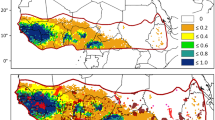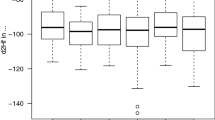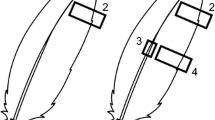Abstract
Hydrogen stable isotope analysis of feathers is an important tool for estimating the natal or breeding latitudes of nearctic-neotropical migratory birds. This method is based on the latitudinal variation of hydrogen stable isotope ratios in precipitation in North America (δDp) and the inheritance of this variation in newly formed feathers (δDf). We hypothesized that the typically strong relationship between δDp and δDf would be decoupled in birds that forage in marine food webs because marine waters have relatively high δD values compared to δD values for local precipitation. Birds that forage on marine prey bases should also have feathers with high δ34S values, since δ34S values for marine sulfate are generally higher than δ34S values in terrestrial systems. To examine this potential marine effect on feather stable isotope ratios, we measured δD and δ34S in the feathers of nine different species of raptors from both inland and coastal locations across North America. Feathers from coastal bird-eating raptors had consistently higher δD and δ34S values than feathers from inland birds. Birds that had high δ34S values also deviated strongly from the typical relationship between δDp and δDf. We recommend measuring both sulfur and hydrogen stable isotope ratios in feathers when some members of a migrant population could potentially forage in marine habitats. We suggest using a practical cutoff of δ34S >10‰ to remove marine-foraging birds from a migrant sample when using stable isotopes of hydrogen to estimate the latitudinal origins of migrants because high δDf values for marine-foraging birds could potentially distort estimates of origins.




Similar content being viewed by others
References
Caccamise DF, Reed LM, Castelli PM, Wainright S, Nichols TC (2000) Distinguishing migratory and resident Canada Geese using stable isotope analysis. J Wildl Manage 64:1084–1091
Chamberlain CP, Blum JD, Holmes RT, Feng X, Sherry TW, Graves GR (1997) The use of isotope tracers for identifying populations of migratory birds. Oecologia 109:132–141
Chukhrov FV, Ermilova LP, Churikov VS, Nosik LP (1980) The isotopic composition of plant sulfur. Org Geochem 2:69–75
Coplen TB (1988) Normalization of oxygen and hydrogen isotope data. Chem Geol 72:293–297
Cormie AB, Schwarcz HP, Gray J (1994) Relation between hydrogen isotopic ratios of bone collagen and rain. Geochim Cosmochim Acta 58:377–391
Cornwell JC, Neill C, Stevenson JC (1995) Biogeochemical origin of δ34S isotopic signatures in a prairie marsh. Can J Fish Aquat Sci 52:1816–1820
Dansgaard W (1964) Stable isotopes in precipitation. Tellus 16:436–468
Dunn OJ, Clark VA (1987) Applied statistics: analysis of variance and regression, 2nd edn. Wiley, New York
Forsman D (1999) The raptors of Europe and the Middle East: a handbook of field identification. Poyser, London
Giesemann A, Jager HJ, Norman AL, Krouse HR, Brand WA (1994) On-line sulfur-isotope determination using an elemental analyzer coupled to a mass spectrometer. Anal Chem 66:2816–2819
Hesslein RH, Capel MJ, Fox DE, Hallard KA (1991) Stable isotopes of sulfur, carbon, and nitrogen as indicators of trophic level and fish migration in the lower Mackenzie River Basin, Canada. Can J Fish Aquat Sci 48:2258–2265
Hintze J (2001) NCSS 2000 statistical software. NCSS, Kaysville, Utah
Hobson KA, Wassenaar LI (1997) Linking breeding and wintering grounds of neotropical migrant songbirds using stable hydrogen isotope analysis of feathers. Oecologia 109:142–148
Hobson KA, Wassenaar LI (2001) Isotopic delineation of migratory wildlife populations in North America: loggerhead shrikes. Ecol Appl 11:1545–1553
Hobson KA, Hughes KD, Ewins PJ (1997) Using stable-isotopes to identify endogenous and exogenous sources of nutrients in eggs of migratory birds: applications to great lakes contaminants research. Auk 114:467–478
Hobson KA, Brua RB, Hohman WL, Wassenaar LI (2000) Low frequency of "double molt" of remiges in ruddy ducks revealed by stable isotopes: implications for tracking migratory waterfowl. Auk 117:129–135
Hobson KA, McFarland KF, Wassenaar LI, Rimmer CC, Goetz JE (2001) Linking breeding and wintering grounds of Bicknell's Thrushes using stable isotope analyses of feathers. Auk 118:16–23
Hoefs J (1980) Stable isotope geochemistry, 2nd edn. Springer, New York Berlin Heidelberg
Jamieson RE, Wadleigh MA (2000) Tracing sources of precipitation sulfate in eastern Canada using stable isotopes and trace metals. J Geophys Res Atmos 105:20549–20556
Johnsgard PA (1990) Hawks, eagles, and falcons of North America. Smithsonian Institute Press, Washington D.C.
Kaluzny SP, Vega SC, Cardoso TP, Shelly AA (1998) S+SpatialStats users manual for Windows and Unix. Springer, New York Berlin Heidelberg
Kelly JF, Atudorei V, Sharp ZD, Finch DM (2002) Insights into Wilson's Warbler migration from analyses of hydrogen stable-isotope ratios. Oecologia 130:216–221
Knoff AJ, Macko SA, Erwin RM (2001) Diets of nesting Laughing Gulls (Larus atricilla) at the Virginia Coast Reserve: observations from stable isotope analysis. Isotopes Environ Health Stud 37:67–88
Kwak TJ, Zedler JB (1997) Food web analysis of southern California coastal wetlands using multiple stable isotopes. Oecologia 110:262–277
MacAvoy SE, Macko SA, McIninch SP, Garman GC (2000) Marine nutrient contributions to freshwater apex predators. Oecologia 122:568–573
MathSoft (2000) Splus 2000 statistical software, release 3. MathSoft, Seattle, Wash.
Meehan TD, Lott CA, Sharp ZD, Smith RB, Rosenfield RN, Stewart AC, Murphy RK (2001) Using hydrogen isotope geochemistry to estimate the natal latitudes of immature Cooper's hawks migrating through the Florida Keys. Condor 103:11–20
Michener RH, Schell DM (1994) Stable isotope ratios as tracers in marine aquatic food webs. In: Lajtha K, Michener RH (eds) Stable isotopes in ecology and environmental science. Blackwell, London, pp 138–157
Miller RF, Fritz P, Morgan AV (1988) Climatic implications of D/H ratios in beetle chitin. Paeleogeogr Palaeoclimatol Palaeoecol 66:277–288
Ratcliffe DA (1980) The Peregrine Falcon. Buteo Books, Vermillion, S.D.
Redfield AC, Friedman I (1965) Factors affecting the distribution of deuterium in the ocean. Symposium on Marine Geochemistry. Rhode Island University Narragansett Marine Laboratory Occasional Publication 3:149–168
SAS Institute (1999) SAS User's Guide, version 8.2. SAS Institute, Cary, N.C.
Wassenaar LI, Hobson KA (2000) Stable-carbon and hydrogen isotope ratios reveal breeding origins of red-winged blackbirds. Ecol Appl 10:911–916
Wassenaar LI, Hobson KA (2001) A stable-isotope approach to delineate geographical catchment areas of avian migration monitoring stations in North America. Environ Sci Technol 35:1845–1850
Wassenaar LI, Hobson K A (2002) Virtual equilibration and online technique for rapid determinations of non-exchangeable (delta d) of feathers for avian migration studies. Isotopes Environ Health Stud (in press)
White JWC (1988) Stable hydrogen isotope ratios in plants: a review of current theory and some potential applications. In: Rundel PW, Ehleringer JR, Nagy KA (eds) Stable isotopes in ecological research. Springer, Berlin Heidelberg New York, pp 142–162
Zar JH (1999) Biostatistical analysis. Prentice-Hall, Upper Saddle River, N.J.
Acknowledgements
This project would never have been possible without the contributions of many organizations and individuals. HawkWatch International would like to thank the Disney Wildlife Conservation Foundation for the Disney Conservation Award that funded this research. We thank the following curators, collections managers, and assistants for their invaluable contributions of feather samples for this study: David Willard and John Bates at the Field Museum of Natural History in Chicago; Kevin McGowan at the Cornell University Museum of Vertebrates; John Gerwin and Becky Browning from the North Carolina State Museum of Natural Sciences; Andrew Kratter at the Florida Museum of Natural History in Gainesville; and Tamar Danufsky at the Wildlife Collection at Humboldt State University. We are very grateful to Zachary Sharp and Viorel Atudorei for timely technical assistance throughout our laboratory analysis in New Mexico. Zachary Sharp also provided helpful comments on an earlier draft of this manuscript. We also thank Mark Chappell and an anonymous reviewer for their insightful comments during the review process. Thanks to Ruth Smith, John DeLong, Jon Larrabee, Aaron Barna, and Steve De La Pena for lab assistance and discussion. We thank the outstanding staff of HawkWatch International for their administrative support and the Florida Fish and Wildlife Conservation Commission for their support of the Florida Keys Raptor Migration Project. Thanks to the staff of Audubon's Tavernier Science Center for office support during the writing of this paper and National Science Foundation grant EAR-9727141 for support of the stable isotope lab at the University of New Mexico.
Author information
Authors and Affiliations
Rights and permissions
About this article
Cite this article
Lott, C.A., Meehan, T.D. & Heath, J.A. Estimating the latitudinal origins of migratory birds using hydrogen and sulfur stable isotopes in feathers: influence of marine prey base. Oecologia 134, 505–510 (2003). https://doi.org/10.1007/s00442-002-1153-8
Received:
Accepted:
Published:
Issue Date:
DOI: https://doi.org/10.1007/s00442-002-1153-8




